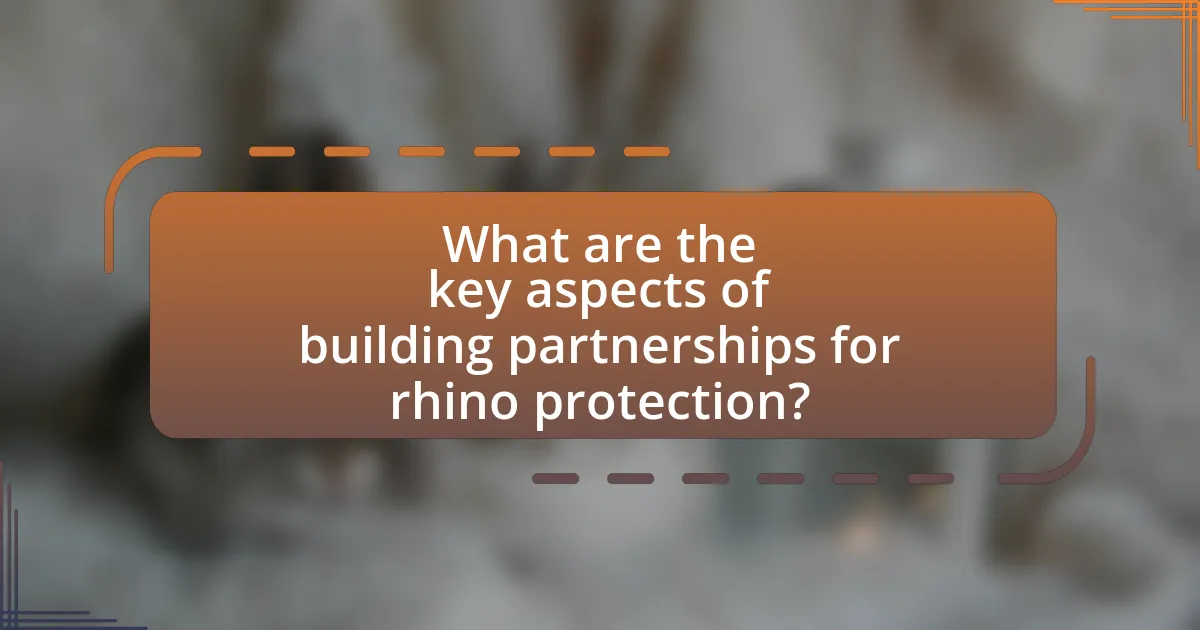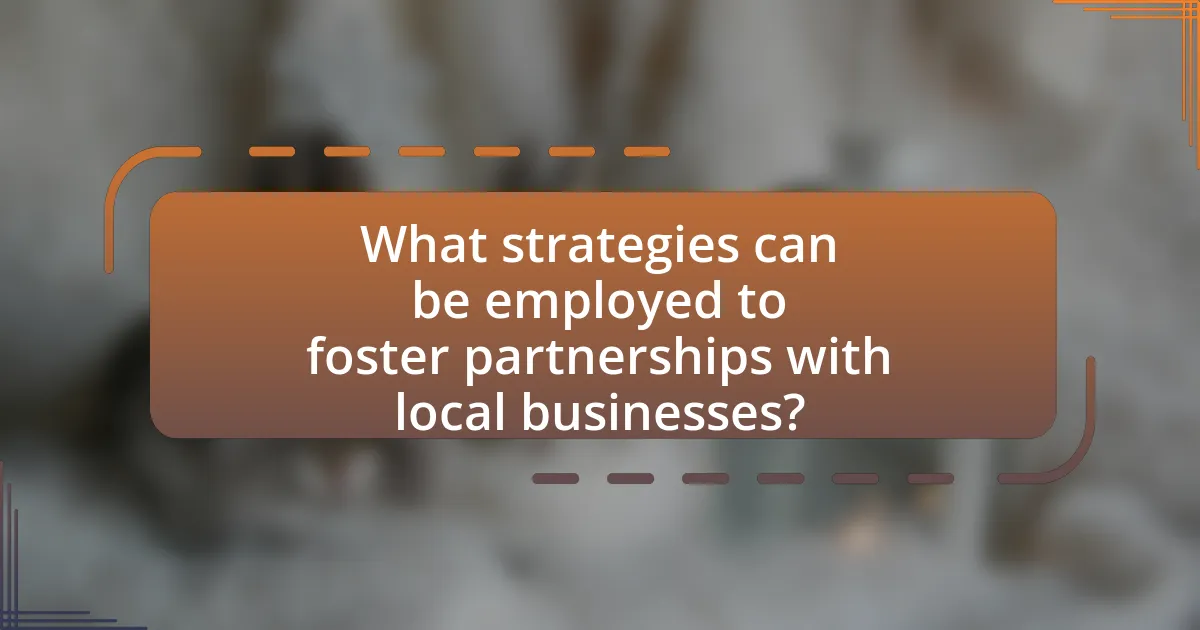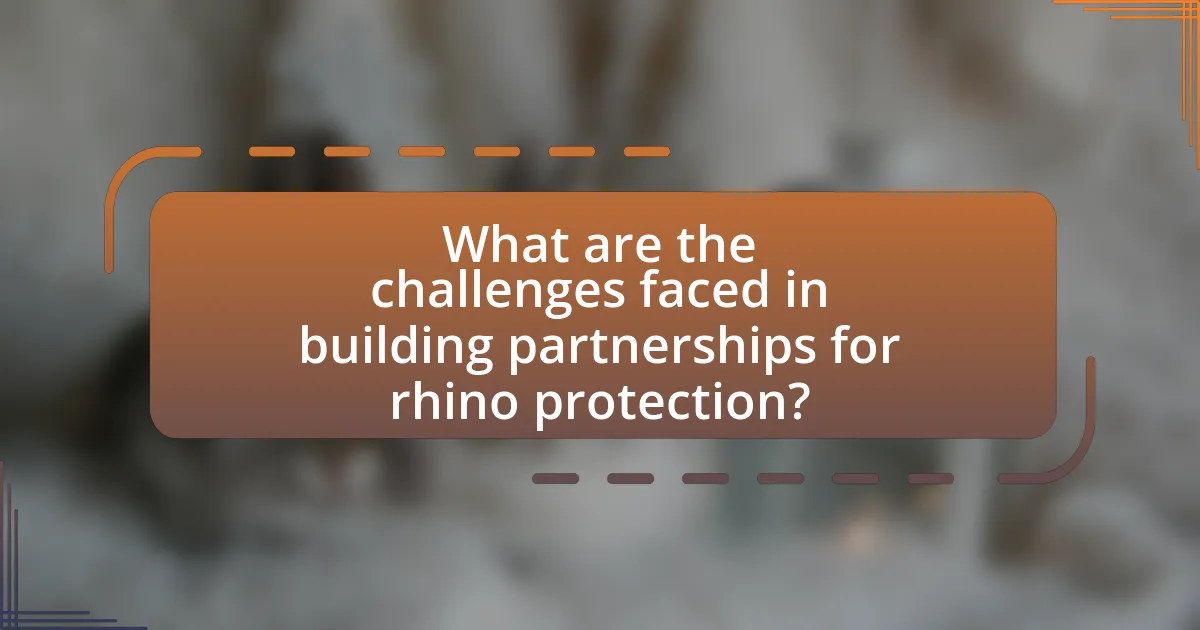The article focuses on building partnerships with local businesses to enhance rhino protection efforts. It outlines key aspects such as collaboration, resource sharing, and community engagement, emphasizing the importance of involving local stakeholders in conservation initiatives. The article discusses how local businesses contribute to rhino conservation through financial support, awareness-raising, and sustainable tourism practices. It also highlights effective strategies for fostering partnerships, addressing challenges, and measuring success, ultimately demonstrating the critical role that collaboration plays in achieving sustainable rhino protection outcomes.

What are the key aspects of building partnerships for rhino protection?
The key aspects of building partnerships for rhino protection include collaboration, resource sharing, and community engagement. Collaboration among various stakeholders, such as local businesses, conservation organizations, and government agencies, enhances the effectiveness of rhino protection efforts by pooling expertise and resources. Resource sharing, including financial support and knowledge transfer, strengthens the capacity of local initiatives to combat poaching and habitat loss. Community engagement is crucial, as involving local populations fosters a sense of ownership and responsibility towards rhino conservation, leading to sustainable protection measures. For instance, successful partnerships in South Africa have demonstrated that when local communities benefit economically from conservation efforts, such as eco-tourism, they are more likely to support rhino protection initiatives.
How do local businesses contribute to rhino conservation efforts?
Local businesses contribute to rhino conservation efforts by providing financial support, raising awareness, and promoting sustainable tourism practices. For instance, many local businesses donate a portion of their profits to conservation organizations, directly funding anti-poaching initiatives and habitat preservation. Additionally, these businesses often engage in community education programs that inform locals and tourists about the importance of rhinos and the threats they face, fostering a culture of conservation. Furthermore, by promoting eco-friendly tourism, local businesses help create economic incentives for communities to protect rhinos rather than exploit them, as evidenced by studies showing that wildlife tourism can generate significant revenue for conservation efforts.
What types of local businesses are most effective in these partnerships?
Local businesses that are most effective in partnerships for rhino protection include eco-tourism companies, wildlife conservation organizations, and local artisans. Eco-tourism companies attract visitors interested in wildlife, providing funding and awareness for conservation efforts. Wildlife conservation organizations often have established networks and expertise in protecting rhinos, making them valuable partners. Local artisans can create products that promote rhino conservation, generating revenue that supports protection initiatives. These types of businesses align their interests with conservation goals, enhancing the effectiveness of partnerships.
How can businesses align their goals with rhino protection initiatives?
Businesses can align their goals with rhino protection initiatives by integrating sustainable practices that support conservation efforts into their operational strategies. For instance, companies can adopt eco-friendly sourcing policies that prioritize products from suppliers committed to wildlife protection, thereby reducing their ecological footprint. Additionally, businesses can engage in corporate social responsibility (CSR) programs that fund rhino conservation projects, such as anti-poaching patrols or habitat restoration, which can enhance their brand reputation and customer loyalty. Evidence shows that companies involved in conservation efforts often experience increased consumer trust; a 2020 study by Cone Communications found that 87% of consumers are more likely to purchase from a company that supports environmental causes. By aligning their business objectives with rhino protection, companies not only contribute to biodiversity preservation but also create a positive impact on their market positioning.
Why is collaboration important for rhino protection?
Collaboration is crucial for rhino protection because it enhances resource sharing, increases awareness, and strengthens conservation efforts. By partnering with local businesses, conservation organizations can leverage financial support, local knowledge, and community engagement, which are essential for effective rhino protection strategies. For instance, initiatives that involve local stakeholders have shown a significant reduction in poaching rates, as seen in South Africa’s Kruger National Park, where community involvement led to a 50% decrease in rhino poaching incidents over a five-year period. This collaborative approach not only fosters a sense of ownership among local communities but also creates sustainable economic alternatives that reduce reliance on illegal activities.
What are the benefits of partnering with local businesses for conservation?
Partnering with local businesses for conservation provides enhanced community engagement and resource mobilization. Local businesses often have established relationships within the community, which can facilitate awareness and support for conservation initiatives. For instance, businesses can contribute financially or through in-kind donations, such as providing venues for events or materials for conservation projects. Additionally, collaboration can lead to shared marketing efforts, increasing visibility for both the conservation cause and the businesses involved. Research indicates that community-based conservation efforts, supported by local enterprises, can lead to improved outcomes for wildlife protection, as seen in various successful initiatives globally.
How does collaboration enhance community engagement in rhino protection?
Collaboration enhances community engagement in rhino protection by fostering shared responsibility and collective action among stakeholders. When local businesses, conservation organizations, and community members work together, they create a unified approach that raises awareness and mobilizes resources effectively. For instance, partnerships can lead to joint initiatives such as educational programs and eco-tourism projects that directly involve the community, thereby increasing local investment in rhino conservation. Research indicates that communities engaged in collaborative conservation efforts are more likely to report positive attitudes towards wildlife protection, as seen in the case of the African Wildlife Foundation’s initiatives in Kenya, which demonstrated a significant increase in community participation and support for rhino protection efforts.

What strategies can be employed to foster partnerships with local businesses?
To foster partnerships with local businesses, organizations can implement strategies such as creating mutually beneficial programs, engaging in community events, and offering incentives for collaboration. Establishing programs that align business goals with conservation efforts, such as sponsorship opportunities for local events focused on rhino protection, encourages businesses to participate actively. Engaging in community events allows organizations to showcase their mission and the importance of rhino conservation, thereby attracting local businesses to join the cause. Additionally, offering incentives, such as tax deductions for donations or promotional opportunities for businesses that support conservation initiatives, can motivate local businesses to partner effectively. These strategies are supported by successful case studies where local businesses have increased their community engagement and brand loyalty through partnerships with conservation organizations.
How can organizations effectively approach local businesses for collaboration?
Organizations can effectively approach local businesses for collaboration by clearly articulating mutual benefits and aligning goals. Establishing a shared vision for rhino protection can motivate local businesses to participate, as they often seek community engagement and positive public relations. For instance, a study by the World Wildlife Fund indicates that businesses involved in conservation efforts can enhance their brand image and customer loyalty. By presenting data on the positive impact of local partnerships on conservation, organizations can create compelling proposals that resonate with business owners.
What communication strategies work best in building these partnerships?
Effective communication strategies for building partnerships with local businesses for rhino protection include establishing clear objectives, fostering open dialogue, and utilizing storytelling to convey the importance of conservation efforts. Clear objectives ensure that all parties understand the goals of the partnership, which enhances alignment and commitment. Open dialogue encourages transparency and trust, allowing businesses to voice concerns and suggestions, thereby strengthening collaboration. Storytelling effectively engages stakeholders by illustrating the impact of their contributions on rhino conservation, making the cause relatable and motivating action. Research indicates that partnerships with shared values and effective communication lead to more successful conservation outcomes, as evidenced by initiatives like the African Wildlife Foundation’s collaborations with local communities.
How can organizations demonstrate the value of partnership to businesses?
Organizations can demonstrate the value of partnership to businesses by showcasing tangible benefits such as increased brand visibility, access to new markets, and enhanced corporate social responsibility. For instance, partnerships that focus on rhino protection can lead to positive media coverage, which boosts brand reputation and attracts environmentally conscious consumers. Additionally, collaborating with local businesses can provide access to a broader customer base, as these partnerships often leverage shared resources and networks. A study by the Harvard Business Review indicates that companies engaged in social partnerships see a 20% increase in customer loyalty, reinforcing the financial advantages of such collaborations.
What role does community awareness play in building partnerships?
Community awareness is crucial in building partnerships as it fosters understanding and support for conservation initiatives. When local communities are informed about the importance of rhino protection, they are more likely to engage with and support partnerships with businesses and organizations focused on conservation. For instance, studies have shown that community involvement in conservation efforts leads to increased local stewardship and participation, which enhances the effectiveness of partnerships. This awareness can also drive local businesses to contribute resources or services, creating a collaborative environment that benefits both the community and conservation goals.
How can awareness campaigns engage local businesses in conservation efforts?
Awareness campaigns can engage local businesses in conservation efforts by highlighting the mutual benefits of collaboration, such as increased customer loyalty and enhanced community reputation. For instance, campaigns can showcase how businesses that support conservation initiatives, like rhino protection, can attract environmentally conscious consumers, thereby boosting sales. Research indicates that 66% of consumers are willing to pay more for sustainable brands, demonstrating a clear financial incentive for businesses to participate in conservation efforts. By providing resources, promotional materials, and recognition for their contributions, awareness campaigns can effectively motivate local businesses to become active partners in conservation.
What are effective methods for raising awareness about rhino protection?
Effective methods for raising awareness about rhino protection include community engagement initiatives, educational programs, and social media campaigns. Community engagement initiatives, such as local workshops and events, foster direct interaction between conservationists and the public, enhancing understanding of rhino conservation issues. Educational programs in schools can teach children about the importance of rhinos and the threats they face, creating a generation that values wildlife protection. Social media campaigns leverage platforms like Instagram and Facebook to reach a broader audience, sharing impactful stories and visuals that highlight the plight of rhinos. According to a study by the World Wildlife Fund, social media campaigns can increase public engagement by up to 60%, demonstrating their effectiveness in raising awareness.

What are the challenges faced in building partnerships for rhino protection?
Building partnerships for rhino protection faces several challenges, including differing priorities among stakeholders, lack of funding, and insufficient communication. Stakeholders such as local communities, conservation organizations, and government agencies often have varying objectives, which can hinder collaborative efforts. For instance, local businesses may prioritize economic gain over conservation, leading to conflicts in partnership goals. Additionally, funding for rhino protection initiatives is often limited, making it difficult to sustain long-term partnerships and projects. A report by the International Union for Conservation of Nature highlights that inadequate financial resources can stall conservation efforts, as many initiatives rely on external funding sources. Lastly, ineffective communication among partners can result in misunderstandings and a lack of coordinated action, further complicating partnership development.
What common obstacles do organizations encounter when collaborating with businesses?
Organizations commonly encounter communication barriers when collaborating with businesses. These barriers can lead to misunderstandings regarding goals, expectations, and responsibilities. For instance, a study by the Project Management Institute found that ineffective communication is a primary cause of project failure, affecting 56% of projects. Additionally, differing organizational cultures can create friction, as businesses may prioritize profit while organizations focus on conservation, leading to conflicting objectives. Furthermore, resource constraints, such as limited funding or personnel, can hinder effective collaboration, as highlighted by the World Wildlife Fund, which notes that many conservation initiatives struggle due to inadequate financial support.
How can organizations overcome financial constraints in partnerships?
Organizations can overcome financial constraints in partnerships by leveraging shared resources and expertise to minimize costs. For instance, collaborating with local businesses allows organizations to access funding, in-kind donations, and volunteer support, which can significantly reduce financial burdens. A study by the Stanford Social Innovation Review highlights that partnerships can lead to cost-sharing arrangements, where organizations pool their financial resources for joint initiatives, thus enhancing their overall impact while mitigating individual financial risks.
What strategies can address differing priorities between businesses and conservation goals?
Strategies that can address differing priorities between businesses and conservation goals include creating incentive programs, fostering collaborative partnerships, and implementing sustainable business practices. Incentive programs, such as tax breaks or grants for businesses that engage in conservation efforts, encourage alignment between profit motives and environmental stewardship. Collaborative partnerships between businesses and conservation organizations can lead to shared resources and expertise, enhancing the effectiveness of conservation initiatives. Additionally, adopting sustainable business practices, such as eco-friendly sourcing and waste reduction, can help businesses meet conservation goals while maintaining profitability. These strategies have been shown to create synergies that benefit both economic and ecological outcomes, as evidenced by successful case studies in various regions where businesses actively participate in conservation efforts.
How can success be measured in these partnerships?
Success in partnerships for rhino protection can be measured through specific metrics such as increased funding for conservation efforts, enhanced community engagement, and improved rhino population statistics. For instance, a partnership that results in a 20% increase in funding for anti-poaching initiatives directly correlates to the financial resources available for rhino protection. Additionally, measuring community involvement through surveys can indicate the level of local support and awareness, which is crucial for sustainable conservation efforts. Finally, tracking rhino population growth or stabilization over time provides a clear indicator of the effectiveness of these partnerships in achieving their conservation goals.
What metrics can be used to evaluate the effectiveness of business collaborations?
Metrics used to evaluate the effectiveness of business collaborations include return on investment (ROI), partnership satisfaction surveys, and the achievement of specific project milestones. ROI measures the financial return generated from the collaboration relative to its costs, providing a clear indicator of economic effectiveness. Partnership satisfaction surveys assess the perceptions and experiences of involved parties, offering qualitative insights into the collaboration’s success. Additionally, tracking the achievement of specific project milestones allows stakeholders to evaluate progress and outcomes against predefined goals, ensuring that the collaboration meets its intended objectives. These metrics collectively provide a comprehensive framework for assessing the effectiveness of business collaborations in various contexts, including initiatives aimed at rhino protection.
How can feedback from local communities inform partnership success?
Feedback from local communities can significantly inform partnership success by providing insights into local needs, preferences, and cultural contexts. This information enables organizations to tailor their initiatives effectively, ensuring alignment with community values and increasing local support. For instance, a study by the World Wildlife Fund highlighted that community engagement in conservation efforts led to a 30% increase in local participation in wildlife protection programs. By actively incorporating community feedback, partnerships can enhance trust, foster collaboration, and ultimately achieve more sustainable outcomes in initiatives like rhino protection.
What are best practices for sustaining partnerships with local businesses?
Best practices for sustaining partnerships with local businesses include establishing clear communication, setting mutual goals, and fostering trust. Clear communication ensures that both parties understand expectations and responsibilities, which is crucial for effective collaboration. Setting mutual goals aligns the interests of local businesses and conservation efforts, creating a shared vision that motivates ongoing participation. Fostering trust through transparency and reliability strengthens the partnership, encouraging long-term commitment. Research indicates that partnerships with defined objectives and open dialogue are more likely to succeed, as evidenced by successful collaborations in community-based conservation initiatives.
How can ongoing communication strengthen partnerships over time?
Ongoing communication strengthens partnerships over time by fostering trust, transparency, and collaboration among stakeholders. Regular dialogue allows partners to share updates, address concerns, and align goals, which enhances mutual understanding and commitment. For instance, studies show that organizations with effective communication strategies are 50% more likely to achieve their partnership objectives. This consistent interaction not only builds rapport but also enables partners to adapt to changing circumstances, ensuring the partnership remains relevant and effective in achieving shared goals, such as rhino protection initiatives.
What role does recognition play in maintaining business engagement in conservation?
Recognition plays a crucial role in maintaining business engagement in conservation by fostering a sense of value and commitment among businesses. When companies receive acknowledgment for their contributions to conservation efforts, such as financial support or active participation in initiatives, it enhances their reputation and strengthens their brand identity. This recognition can manifest through awards, public endorsements, or visibility in media campaigns, which not only incentivizes continued involvement but also encourages other businesses to participate. For instance, a study by the World Wildlife Fund found that businesses recognized for their sustainability efforts reported a 30% increase in employee engagement and a 25% increase in customer loyalty, demonstrating that recognition directly correlates with sustained business engagement in conservation activities.
